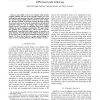Free Online Productivity Tools
i2Speak
i2Symbol
i2OCR
iTex2Img
iWeb2Print
iWeb2Shot
i2Type
iPdf2Split
iPdf2Merge
i2Bopomofo
i2Arabic
i2Style
i2Image
i2PDF
iLatex2Rtf
Sci2ools
ICRA
2010
IEEE
2010
IEEE
Autonomous flight at low altitude with vision-based collision avoidance and GPS-based path following
The ability to fly at low altitude while actively avoiding collisions with the terrain and other objects is a great challenge for small unmanned aircraft. This paper builds on top of a control strategy called optiPilot whereby a series of opticflow detectors pointed at divergent viewing directions around the aircraft main axis are linearly combined into roll and pitch commands using two sets of weights. This control strategy already proved successful at controlling flight and avoiding collisions in reactive navigation experiments. This paper shows how opitPilot can be coupled with a GPS in order to provide goal-directed, nap-of-the-earth flight control in presence of static obstacles. Two fully autonomous flights of 25 minutes each are described where a 400-gram unmanned aircraft is flying at approx. 9 m above the terrain on a circular path including two copses of trees requiring efficient collision avoidance actions.
| Added | 13 Feb 2011 |
| Updated | 13 Feb 2011 |
| Type | Journal |
| Year | 2010 |
| Where | ICRA |
| Authors | Jean-Christophe Zufferey, Antoine Beyeler, Dario Floreano |
Comments (0)

